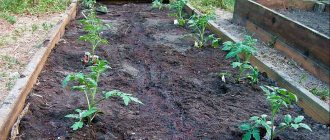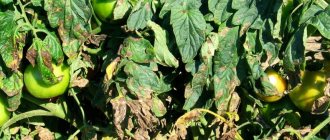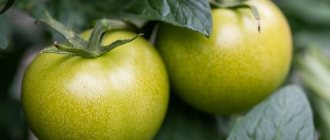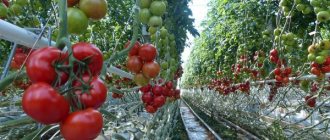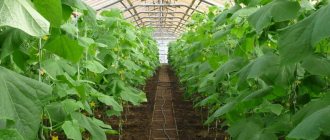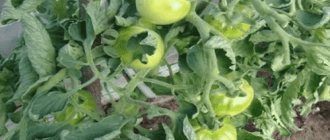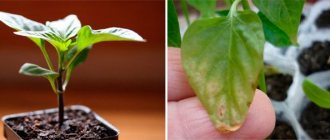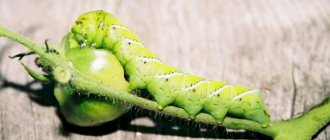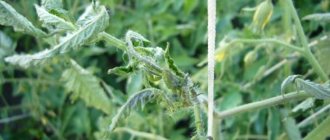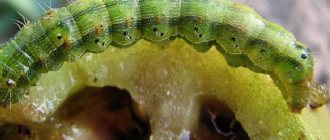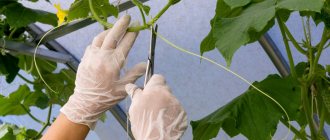With your help, I think I managed to cope with the acidity of the soil. Tomatoes are developing well. They bloom powerfully, the leaves are dark green. But in the middle row opposite the doors, the tops of the tall tomatoes seem to be “curled up”, curled into a “fist”. I read literature. Explanations vary. Basically, I fill it with too much water. This is not the case, because I rake the soil, it is dry. There may be insufficient watering. The middle row is practically blown through and the soil dries faster than the side beds. The plants are tall, powerful, and bloom. I think they need good watering. Not 2 times a week, as they say in various reference books. With such heat in a polycarbonate greenhouse, the soil dries out very quickly. Maybe I'm wrong. Tell me what to do. Previously, there were no such problems when growing tomatoes in homemade greenhouses. Best regards, Valentina. Hello, Valentina! Many summer residents face this problem. Tomato leaves can become curly for various reasons. You indicated one of them correctly - insufficient watering during hot periods. A plant experiencing a lack of moisture will have curled leaves. Thus, the tomato manages to reduce moisture evaporation by reducing the surface area of the leaf plate. At the same time, the lower leaves, illuminated less by the rays of the sun and better ventilated, remain normal.
Important! Choose a watering mode based on the appearance of the plants. But remember that excess moisture provokes the occurrence of fungal diseases.
Why do the tops of tomatoes curl in a greenhouse?
With your help, I think I managed to cope with the acidity of the soil.
Tomatoes are developing well. They bloom powerfully, the leaves are dark green. But in the middle row opposite the doors, the tops of the tall tomatoes seem to be “curled up”, curled into a “fist”. I read literature. Explanations vary. Basically, I fill it with too much water. This is not the case, because I rake the soil, it is dry. There may be insufficient watering. The middle row is practically blown through and the soil dries faster than the side beds. The plants are tall, powerful, and bloom. I think they need good watering. Not 2 times a week, as they say in various reference books. With such heat in a polycarbonate greenhouse, the soil dries out very quickly. Maybe I'm wrong. Tell me what to do. Previously, there were no such problems when growing tomatoes in homemade greenhouses. Best regards, Valentina. Hello, Valentina! Many summer residents face this problem. Tomato leaves can become curly for various reasons. You indicated one of them correctly - insufficient watering during hot periods. A plant experiencing a lack of moisture will have curled leaves. Thus, the tomato manages to reduce moisture evaporation by reducing the surface area of the leaf plate. At the same time, the lower leaves, illuminated less by the rays of the sun and better ventilated, remain normal.
Important! Choose a watering mode based on the appearance of the plants. But remember that excess moisture provokes the occurrence of fungal diseases.
Excess moisture
Increased soil moisture also causes leaves to curl. In this case, the leaves curl upward, resembling a boat. If tomatoes grow in open clay soil, there are long rains, the soil is saturated with water, as the water slowly goes to depth. The roots literally suffocate from lack of air, and the tops curl up.
This problem can be avoided even at the stage of planting seedlings. When planting seedlings, the hole must be filled with loose soil. And also loosen the soil, excess moisture will evaporate faster.
Excess nitrogen in the soil
If there is an excess amount of nitrogen fertilizer in the soil, the plant begins to fatten. At the same time, the plants have powerful stems, dark green leaves and curly tops. The plant directs all its strength to the growth of green mass. Unfortunately, there will not be a large harvest of fruits if measures are not taken.
It is necessary to balance the amount of fertilizer in the soil by fertilizing with potassium, which is contained in wood ash. Dilute a glass of ash in a bucket of water and pour over the tomatoes. Spraying the leaves with a solution prepared from one teaspoon of potassium sulfate and a liter of water also helps.
Bad feeding
Organic substances (rotted grass, manure, ash, etc.) cannot provide the plant with everything it needs to grow. Manure releases a lot of ammonia, which burns the foliage. As a result, it begins to curl and dry out.
An excess of manure is also harmful because the bushes begin to grow green mass, directing all their energy to this instead of setting fruit. In order not to lose juicy and ripe tomato fruits, feed the bushes only with well-rotted manure or compost. Don't skimp on complex feedings. They are sold in all gardening stores.
To feed the bushes, dissolve a glass of ash in a bucket of water and apply it under each bush. Experienced gardeners use a teaspoon of potassium sulfate, which is also dissolved in a bucket of warm water.
Phosphorus, copper, zinc, calcium, iron and other trace elements are very important for plant health. A lack of these elements can lead not only to yellowing of the leaves, but also to other troubles.
Tricks of aphids
Small black aphids, which first settle in the axils of the leaves and then move to the stem and petioles of the leaves, can also cause leaf curling. When sucking juices, aphids introduce a specific substance into the plant tissue, which deforms the stem and curls the leaves. Insects hidden in leaf folds are difficult to kill with insecticides.
Important! When spraying, try to wet all the axils and folds of the leaves.
A sick plant under the pressure of aphids looks exactly as you describe
Curling of leaves due to insect attack
Various insects strive to feast on the juices of tomato leaves. As a result of such parasitism, the leaves begin to wither, turn yellow, curl and dry out. Curling of leaves on tomatoes in a greenhouse can occur as a result of parasitism by aphids, spider mites or whiteflies.
Important! Insect pests often parasitize young leaves at the top of tomato plants, located on the back side. It is worth noting that a spider mite, during its life activity, can tightly wrap a tomato leaf with its web, creating a tube-shaped home for itself
Black aphids, when sucking out nutrients, inject a special substance that poisons the plant and causes the leaves to curl and turn yellow.
It is worth noting that a spider mite, during its life activity, can tightly wrap a tomato leaf with its web, creating a tube-shaped home for itself. When black aphids suck out nutrients, they inject a special substance that poisons the plant and causes the leaves to curl and turn yellow.
Insects can be controlled using various chemicals or by attracting them into traps. Among folk remedies for pest control, spraying plants with a decoction of chamomile or yarrow shows high effectiveness. Tobacco infusion can also repel harmful insects.
The tops and leaves of the tomatoes curl. When to worry and when not to.
Hello, dear friends. Welcome to the website of the “Dacha Stories” .
Very often we hear complaints from summer residents about curling leaves or tops of tomato plants. Let's look at the possible reasons, and I will try to describe everything as simply as possible so that you can determine your case without any problems.
By and large, if you group all the reasons according to a common characteristic, then there will not be very many of them, no more than five or six, but there can be many variations.
1. Problems with the root system.
A.
Damage to the root system during planting (transplanting), loosening.
B.
Excessive watering or drying out. Very often, with insufficient watering in hot weather, the leaves, including the tops of tomatoes, begin to curl. To put it roughly, this is how tomatoes try to stop the evaporation of moisture from the leaf by exposing not the entire width of the leaf plate to the sun.
If you have already decided to water the tomatoes, you need to take at least half a bucket of water per bush. Moreover, it is necessary to water in at least two approaches, because if you pour half a bucket under the bush at once, the water will simply spread out without reaching the root system.
IN.
During hot weather and lack of watering, it is not uncommon for the roots to become very overheated; in this case, a layer of dried grass in the form of mulch will help.
G.
Unrotted organic matter (manure) almost always leads to suppression of the root system and the plant begins to wither and very often the leaves curl.
D.
Do not overdo it and water the tomato more than a bucket for one plant. And even more so, water very often. Due to excess moisture, the tops of the bushes also begin to turn yellow and curl.
2. Unfavorable growing conditions.
A.
At a constant elevated temperature (more than +35) in the greenhouse and lack of air circulation, the tomatoes begin to wither, stop growing and the upper leaves begin to curl.
B.
Tomatoes grow in shade or partial shade and do not receive the required amount of light, which leads to a “suspension” of photosynthesis, which in itself has a disgusting effect on their development.
IN.
Too many stepsons or leaves given at one time.
3. Incorrect fertilizing or violation of fertilizer application standards.
Paradoxical as it may seem, this is probably the most common reason for the curling of the tops and leaves of a tomato at the beginning of summer.
Tomatoes need constant feeding; fertilizers must be applied at least once every ten days both in the greenhouse and in the open ground. However, very often the tops of tomatoes curl due to an excess of organic matter and too much nitrogen fertilizers.
In the first half of summer, you should not be afraid of this, but in the second half, this can lead to fattening of the tomato. That is, if you apply too much fertilizer (no matter mineral or organic), the plant begins to give all the fertilizer to the green parts, forgetting about the fruits.
Bad feeding
Often, even the most experienced gardeners do not know why the tops of tomatoes curl, but it is important for tomatoes to fertilize once every 2 weeks, no matter where the seedlings grow - in open soil or in a greenhouse. According to experts, the main mistake gardeners make is that they are too keen on organic additives.
Manures, nitrogen fertilizers, and various herbs are good fertilizers, but they cannot provide adequate nutrition for the root system of tomatoes. An excess of manure fertilizer releases too much ammonia into the soil, which subsequently burns the plant and then wilts.
At such a moment, the bush becomes fattened, that is, instead of giving up all the vitamins for fruit growth, the plant begins to give up all its elements for growing greenery.
Types of feeding
It is necessary to buy only high-quality manure or compost and give the plant all types of fertilizer: organic, mineral and combined.
- If we talk about mineral fertilizers, tomatoes need to be sprayed with boric acid for normal growth and stable immunity. This feeding stimulates fruit growth and promotes the formation of ovaries. Treatment must be done in the evening so that the solution dries more slowly.
- Organic fertilizers have a beneficial effect on both the soil and the plant. Such fertilizers saturate tomatoes with useful elements and accelerate fruit growth. Most often, wood ash is used as an organic fertilizer. It is the source of many useful elements (potassium, magnesium, etc.), which protect tomatoes from various pests and diseases and accelerate the process of growth and ripening of fruits. The solution for watering tomatoes is quite simple to make: 2 cups of ash, pour 10 liters of boiling water and leave for 3 days. After this, filter the resulting solution and water the bushes with it.
- As for combined feeding, most often, experienced breeders use the following fertilizer: for 30 kg of humus you need to add 500 g of ammonium nitrate, 2 kg of ash and 6 kg of soil from your site. All ingredients must be mixed and the resulting mixture scattered over the garden bed with tomatoes.
Causes of the problem
Tomatoes immediately react to unsuitable conditions for growth and development. There are many reasons why the tops curl. Let's look at the most common ones:
Tatyana Orlova (candidate of agricultural sciences):
One of the possible causes of shredding and curling of the upper leaves on tomatoes is viral diseases, such as aspermia. To understand the nature of the disease, you need to remember that all fungal and bacterial diseases begin from the lower leaves, and viral diseases - from the upper ones.
Tomato leaves can become curled due to damage from various pests.
Some of the most common pests are aphids and whiteflies. They need to be dealt with as soon as possible to prevent serious diseases.
It hides under the leaves and feeds on their juice, which sometimes leads not only to curling of the tops, but also to a change in the shape of the stem.
To combat aphids, both chemicals and traditional methods are used. It all depends on the area of damage and the period of development of the tomatoes.
Tatyana Orlova (candidate of agricultural sciences):
During a season, under favorable conditions, aphids can produce up to 10-12 generations! Therefore, do not think that by getting rid of aphids at the beginning of summer, you have solved the problem forever. Watch for winged aphids on your plants. Their appearance indicates that the aphids have begun to spread again.
Chemicals
It is necessary to treat crops against aphids with chemicals with extreme caution, since they are completely removed from tomatoes after 25-30 days, so fruits that have almost reached maturity must be picked and placed in a dark room until fully ripe.
To combat the pest, you can use insecticides such as:
In addition to chemical agents, there are also biological preparations that can be used 2 days before harvesting the fruits. Such preparations are Fitoverm and Aktofit. An ampoule of the drug (4-6 ml) is diluted in 1 liter of water and the plants are treated with it.
All chemicals are used according to instructions and at a temperature not lower than 16°C. If it is lower, the drug does not work.
Tatyana Orlova (candidate of agricultural sciences):
High temperature also negatively affects the effectiveness of the prepared drug. As a rule, all chemical protection products are water-based. High air temperature promotes rapid evaporation of the substance. The drug simply won’t even have time to work. Therefore, it is recommended to use plant protection products in the morning and evening hours, when the air temperature is below +25 degrees.
In the greenhouse, all chemical treatments must be carried out with extreme caution, wearing special clothing; the greenhouse after treatment is left open overnight.
Traditional methods
You can get rid of aphids
Traditional methods are used as an alternative to chemicals to control aphids. A good solution is a soap solution. To prepare it you need:
Tomato leaves are treated with this product, not forgetting their lower part.
Soap foam, which is used to wash damaged leaves, also helps in the fight against aphids. You can also try to kill pests by washing them off with a strong stream of water.
Aphids do not tolerate garlic solution. To prepare it, use 3 cloves of garlic and 0.5 tbsp. water. This product is infused for 3 days, after which it is filtered, added to 1 bucket of water and the culture is treated.
Folk remedies will be beneficial if used regularly: once every 7-10 days.
Prevention
To prevent the appearance of aphids, you need to dig up 10-15 cm of soil in the fall after harvesting. For the winter, it is not leveled, but left loosened.
In the spring, the area allocated for tomatoes is treated with fufanon solution. To prepare it, take 60 g of the drug and dilute it in 10 liters of water.
Equally important is the correct planting pattern for tomato seedlings. It is necessary to take into account the distance between the bushes. It should not be less than 30 cm in a row and 70 cm between rows.
Near the area with tomatoes, anthills are destroyed so that the ants do not transfer aphids to the seedlings.
Tatyana Orlova (candidate of agricultural sciences):
Unfortunately, it is not possible to completely and permanently remove ants from your site. They leave one place and migrate to another. But to control their numbers, use the drugs Muracid and Medvetox in the form of granules. Several granules of these drugs are placed in the passages of the anthill and in a short time the ants disappear in it
Whitefly
The leaves begin to curl due to whitefly infestation. She, like aphids, hides under tomato leaves. Adults are more harmful than larvae. If the quantity is small, the damaged leaves are torn off, but this is not a very effective method.
To completely get rid of this pest, use chemicals such as:
Treatment of fusarium
The fight against this dangerous disease must begin with prevention. It consists of processing seed material, equipment, changing the place where tomatoes are planted, and selecting varieties that are resistant to fusarium. These are mainly hybrid varieties, such as Monica, Rhapsody, Charisma, Ural, Volovye Heart, Spartak and others.
If the seeds have not been treated, you can spray the seedlings and soil.
Considering that the fungus only affects nightshade crops and lives in the ground at a depth of 10 cm, you can get rid of it if you do not plant tomatoes in the same place.
Fortunately, the disease fusarium is much less common than late blight or gray rot, but it must be dealt with so as not to lose the entire harvest. If you carry out all the listed preventive measures, then diseases will not be terrible.
With fusarium blight, tomatoes wither because their vessels are clogged with mycelium. If you cut the stem of a plant, the vessels on the cut are brown. When plants are severely damaged, they cannot be treated. They can be cured only at the initial stage of the disease, while there are still gaps in the vessels.
Biological agents and chemicals are used for treatment. Biological agents are strains of beneficial bacteria that will fight harmful flora.
To combat the fungus, there is a product called Trichodermin, which should be applied at a rate of 2 g per seedling. Another remedy helps well - Plakriz, the solution is prepared according to the instructions included with the drug, and 100 mg is applied to each tomato bush. There are other biological drugs - Trichocil, Alirin-B.
Chemical preparations - Benazol, Strekarom, Fundazol - are more effective than biological ones, but have one significant drawback: after their use, the fruits cannot be eaten for several weeks. Therefore, it is recommended to do the treatment 3 weeks before harvesting. In order not to use chemicals, you can treat the beds with potassium permanganate and copper-containing preparations before planting tomato seedlings.
Not enough potassium.
The edges of the leaves on tomatoes begin to curl, after which they gradually dry out, which means that the plants do not have enough potassium.
5. Tomato leaves begin to curl downwards.
This phenomenon is a fairly serious sign that the plants are affected by bacterial cancer. At first, the lower leaves begin to curl, then they turn brown and eventually simply dry out, then this is indeed a sign of the plant being damaged by cancer. All such plants must be uprooted and burned so as not to spread this infection throughout the area. But before destroying plants, you should be one hundred percent sure of this. To do this, you need to cut off one stem of the diseased plant, and if there is a brown spot on the cut, then there will be no doubt that the plant is affected by bacterial cancer; it must be destroyed immediately.
Bacterial infections
Tomato tops become frizzy due to bacterial infections. Most often this is tomato bacteriosis. At first the leaves spin, then become smaller at the top and become discolored.
This infection is transmitted by seeds and is very difficult to cure. It is better to destroy the affected bushes and treat the soil with Farmayod. Take 10 ml of the drug per 1 liter of water. The next season, mustard is planted in this area. It disinfects the soil.
Bacterial infections are the most serious cause of leaf curl in tomatoes. It leads to the complete death of the plant.
Main reasons
Most often the problem is heat, lack of fresh air and changes in microclimate. These are violations of agricultural practices that have a bad effect on any plant, and tomatoes are no exception.
Varietal features
Before you sound the alarm, study the characteristics of your seedling variety. For example, there are several small species for which curly leaves are absolutely normal.
Heat
If the temperature around has long exceeded 30 degrees, then the tomatoes are simply very hot. The leaves are curling because they are trying to escape this heat. In this case, partial shade and more fresh air are needed.
Low temperature
If tomatoes are unexpectedly frozen due to a hard frost or other reason, the leaves may also curl. This is a natural reaction of the plant to stress, but under favorable conditions it will recover on its own.
Dryness
The tomato is not the most capricious plant, but it still requires regular watering. And the hotter it is, the more often you will have to do this, up to once every 2-3 days on hot days. Be sure to monitor the condition of the soil and keep in mind that the roots of tomatoes are quite deep, so you need to water the soil well and not superficially.
Excess moisture
When water stagnates in the soil, a favorable environment for the development of fungi is formed, and the roots begin to rot. In this case, the tomato leaves curl not down, but up along the edges. It is necessary to dry the soil and carry out preventive treatment with fungicides.
Root damage
When the root system is damaged, the plant always directs all resources to its restoration. Therefore, carefully loosen the soil and replant the seedlings, use preparations for immunity and rooting. If the leaves begin to curl after planting in the garden, under favorable conditions they will recover within a couple of weeks.
Lack of nutrition
All garden crops need regular fertilizing, because most problems arise precisely due to lack of nutrition. In this case, the leaves not only curl, but also turn yellow, fade, become stained, or dry out at the edges. We recommend combining root feeding with spraying.
Oversupply
When there is too much fertilizer in the soil, it is even more dangerous than when there is not enough of it. Most often this happens when adding organic matter, because it seems more harmless. But too much microelements leads to developmental disorders and can even destroy the plant due to burns to the roots.
Too much nitrogen leads to the fact that the lower leaves grow excessively fleshy and large, and the upper ones curl. And when there is too much zinc, the leaves curl down, hang and turn purple. In any case, you need to urgently stop feeding and you can try to slightly reduce the reaction with sawdust, ash or shavings.
Late stepsoning
Tomatoes should always be divided on time, up to 7 cm, because stepsons that are too large take up a lot of resources. The plant constantly suffers due to stress and nutritional deficiency, so the leaves begin to curl.
Thickening the beds
If tomatoes are planted too close, they are simply cramped and lack sun and air. Because of this, the leaves curl and wither, fungus develops and the tomato withers. When disembarking, be sure to maintain the recommended distances.
Diseases
Most often, a fungus affects the leaves, but it is easy to identify by other symptoms - the presence of plaque, a change in color. The upper leaves become deformed if the tomatoes are affected by stolbur. And if the plates curl, wither and turn black, this could be bacterial cancer.
Pests
Some pests build nests on the underside of leaf blades, causing the leaves to curl. These are ordinary aphids or whiteflies that are much more dangerous for tomatoes. During their life, they secrete a sweet substance, which causes the leaves to stick together even more and the fungus to progress.
Lack of calcium in the soil - yellow spots on the leaves
But the likelihood of an insufficient amount of calcium in the soil is small, since the soil is periodically limed and fertilized, so the cause of disease in the cultivated crop may be the use of large doses of nitrogen-containing fertilizers, which makes it difficult for plants to absorb calcium microelements. For non-root feeding, you can use calcium nitrate, which should be dissolved in water in the correct proportion (20 grams per 10 liters of water).
Tomato leaves with a lack of calcium in the soil
Incorrect pinching and pinching of tomatoes
The reason why the leaves of tomatoes curl in a greenhouse may be improper pinching and pinching of the bushes.
A mistake could be the massive removal of all lower leaves immediately after planting the seedlings in the greenhouse or in the next two weeks.
They can be picked no earlier than 3 weeks after the tomato has been planted in its permanent place. Such actions help improve ventilation of the plant, and therefore reduce humidity. In addition, more light, moisture and nutrients will be directed to the development of ovaries and fruits.
Pinching is a necessary procedure during which side shoots are removed from tomatoes. Only stepsons whose length is 10 centimeters or more can be removed.
Common mistakes
It must be said that tomato bushes quickly react to unfavorable conditions. This can manifest itself in drying out and wilting of green vines. When tomato leaves begin to curl, it is difficult for the plant to receive enough sunlight, which will certainly affect the quality and quantity of the fruit.
The curling of leaves is just a consequence. The reasons could be anything:
- overfeeding or underfeeding with mineral and organic substances;
- improper or irregular watering;
- unsuitable microclimate for tomatoes in the greenhouse;
- incorrect planting of bushes;
- infection by bacteria, viruses;
- attack of insect pests.
Each plant adapts to current conditions. When there is not enough moisture, the bushes begin to save life-giving moisture, and accordingly, not all plant organs receive it. The leaves begin to curl so that less water evaporates from their surface. Infrequent watering conducts moisture only to the upper layers of the soil, while the lower layers do not receive it at all.
Make sure that the water does not spread over the entire ridge; for this, an earthen roller is usually made around each bush.
Watering should be very plentiful, especially if you are growing tomatoes in clay soil. In this case, frequent watering must be carried out in conjunction with measures to remove excess moisture from the roots. After all, poor drainage can lead to withering of bushes due to lack of oxygen.
Moreover, when planting bushes in clay soils, you need to prepare holes with loose soil so that the roots receive enough oxygen.
Ash is an alternative to synthetic mineral fertilizers
Instead of ready-made mineral products, many vegetable growers add ash, which contains potassium, phosphorus and all the microelements plants need, and in an easily digestible form. The ash remaining after burning sunflower tops, straw, birch, pine, fruit trees, grass and shrubs is considered a worthy replacement for many mineral and microfertilizers.
The easiest way to feed, if you don’t know what to do when tomato leaves curl, is to water the plants at the root and spray them with an ash infusion from a spray bottle, which is prepared by diluting two glasses of sifted ash in 10 liters of water (leave for a day before pouring into Strain the sprayer; filtration is not required before watering the bushes).
Causes of yellowing leaves in tomatoes
Some reasons for yellowing leaves are common - both when growing tomatoes in a greenhouse and in open ground.
For example, sometimes tomato leaves turn yellow when the roots are damaged during transplantation of seedlings to a permanent location. Sometimes the seedlings are cramped in the containers in which they were planted, and the roots are damaged during growth. And also the root system can be damaged already in the garden bed due to inaccurate loosening or weeding.
In some cases, tomatoes are difficult to tolerate transplanting. Especially if the conditions for growing them have changed significantly - temperature, humidity, soil characteristics.
Nature arranges it in such a way that in such situations all forces are directed towards the growth of shoots, and the first leaves, having served their purpose, turn out to be superfluous and turn yellow from a lack of nutrients.
In these cases, you don’t need to do anything: the tomatoes will adapt to the new place, straighten their roots and grow additional ones. They will need strength for this process for some time. Tomatoes may drop yellow leaves that are starved of nutrients. Their condition is quickly restored.
To help seedlings take root faster, you can spray them with compositions to stimulate growth - “Kornevin”, “Epin”, “Zircon”.
But there are many situations when plants need help.
In the greenhouse
Most often, greenhouse tomatoes begin to turn yellow due to errors in care. The following conditions are unacceptable to tomatoes:
In an open garden
Although in most regions tomatoes do better outdoors than in a greenhouse, outdoor tomatoes are more dependent on climate and weather conditions.
Therefore, the causes of yellowness may be:
Overheating of plants
Tomatoes are heat-loving plants, but at the same time they cannot tolerate too high temperatures. Overheating causes the upper leaves of the plants to wither, the shoots to dry out, and the tomatoes to become brittle. If the temperature in the greenhouse remains at 35°C for 4 hours, then the first signs of plant oppression appear. Tomato leaves become colorless, flowers and buds begin to fall off.
When the temperature rises to 40°C, the leaves not only wither, but also begin to fall off. A draft and spraying with a solution of zinc salts will help save the situation. Overheating is the most common mistake made by summer residents, who are convinced that the warmer it is, the more comfortable the tomatoes.
To monitor temperature indicators in the greenhouse, you need to place a thermometer in it.
Why do the tops of tomatoes curl in a greenhouse?
With your help, I think I managed to cope with the acidity of the soil. Tomatoes are developing well. They bloom powerfully, the leaves are dark green. But in the middle row opposite the doors, the tops of tall tomatoes seem to be “curled up”, curled into a “fist”.
I read literature. Explanations vary. Basically, I fill it with too much water.
This is not the case, because I rake the soil, it is dry. There may be insufficient watering. The middle row is practically blown through and the soil dries faster than the side beds. The plants are tall, powerful, and bloom.
I think they need good watering. Not 2 times a week, as they say in various reference books. With such heat in a polycarbonate greenhouse, the soil dries out very quickly. Maybe I'm wrong.
Many summer residents face this problem. Tomato leaves can become curly for various reasons. You indicated one of them correctly - insufficient watering during hot periods. A plant experiencing a lack of moisture will have curled leaves.
Thus, the tomato manages to reduce moisture evaporation by reducing the surface area of the leaf plate
At the same time, the lower leaves, illuminated less by the rays of the sun and better ventilated, remain normal. Important! Choose a watering mode based on the appearance of the plants
But remember that excess moisture provokes the occurrence of fungal diseases
Choose a watering mode based on the appearance of the plants. But remember that excess moisture provokes the occurrence of fungal diseases.
Excess nitrogen in the soil
If there is an excess amount of nitrogen fertilizer in the soil, the plant begins to fatten. At the same time, the plants have powerful stems, dark green leaves and curly tops. The plant directs all its strength to the growth of green mass.
Unfortunately, there will not be a large fruit harvest if measures are not taken. It is necessary to balance the amount of fertilizer in the soil by fertilizing with potassium, which is contained in wood ash. Dilute a glass of ash in a bucket of water and pour over the tomatoes. Spraying the leaves with a solution prepared from one teaspoon of potassium sulfate and a liter of water also helps.
Tricks of aphids
Small black aphids, which first settle in the axils of the leaves and then move to the stem and petioles of the leaves, can also cause leaf curling. When sucking juices, aphids introduce a specific substance into the plant tissue, which deforms the stem and curls the leaves.
Insects hidden in the folds of leaves are difficult to kill with insecticides. Important! When spraying, try to wet all the axils and folds of the leaves. A sick plant under the pressure of aphids looks exactly as you describe
Curly virus
This is perhaps the most unpleasant reason, because viral diseases of tomatoes cannot be treated. Plants become infected through insects and cutting tools. It is better to remove diseased tomatoes immediately so as not to infect other plants.
Break out the stepsons manually without using pruners.
Add your comment
General information about culture
Tomato is an annual crop of the Solanaceae family. Grows on any soil and even without it. But to obtain a bountiful harvest, you still need fertile soil flavored with phosphorus, potassium and nitrogen. The acidity should be neutral.
The predecessors of the crop should not be related plants: potatoes, eggplant, peppers. They can transmit diseases characteristic of the family, which will negatively affect the growth and fruiting of the tomato.
It is grown by sowing seeds for seedlings in a greenhouse. Work begins 1.5 - 2 months before the start of the season for planting vegetables in the ground.
On a note! To speed up germination, seeds are soaked in a solution of boric acid.
The grown seedlings are planted up to the cotyledon leaves and covered with soil. Until the seedlings take root, they need to be watered every day. In the future, watering should be abundant, but not frequent, approximately once every 7 days.
The harvest is harvested in the morning or evening. You can pick the fruits even slightly unripe: they ripen well in the box on their own, the bush does not need to waste energy on them.
Tomato contains a large amount of vitamins and minerals, microelements. Even when salted it does not lose its positive qualities. Tomato in the diet is indispensable for the prevention of cancer, cardiovascular diseases, and the genitourinary system.
Soil problems
Due to the inability to apply crop rotation, the soil in the greenhouse “deteriorates” faster than garden soil. The soil becomes depleted, accumulates toxins after chemical treatments and nutrients, and becomes a permanent refuge for fungal spores and pests for wintering. An imbalance of microelements in the soil or obstacles to their consumption is another reason for leaf curl.
In soils with high acidity, there is often a lack of elements important for tomatoes. But plants growing on alkaline soil cannot fully absorb them, even if the soil is saturated with useful substances. To grow tomatoes, the soil in the greenhouse must be neutral or slightly acidic.
If the leaves curl upward, the plant may need copper, magnesium, molybdenum or have an excess of boron, zinc, magnesium. If the leaves curl down, there is likely a lack of zinc, calcium, and boron.
Lack of microelements
Ideally, laboratory analysis of soil samples is necessary; a less reliable way is to try to determine the need for microelements by other criteria.
As a response to a lack of microelements, foliar spraying is recommended.
A strategic solution to the issue is to periodically (every 2-3 years) replace the soil in the greenhouse. You can use the soil on which cabbage, pumpkin, cucumber, beets, turnips, carrots, and green onions grew last season. It is necessary to adjust the structure and acidity of the soil to values that are optimal for tomatoes.
Nutritional imbalance
No matter how nutritious the soil is initially, after some time it becomes depleted. In this regard, to obtain a bountiful harvest, the summer resident must use various fertilizers. A poor plant appearance may be the result of an incorrectly selected fertilizer dosage. This can be either a deficiency or an excess of nutrients.
- with excess nitrogen, the stems and side shoots increase in size, the leaves become curly;
- with a lack of potassium, the leaves curl and turn brown, and the veins change to a yellow color;
- the leaves will indicate a lack of phosphorus in a gray-green color, the veins in red-violet;
- With a lack of copper, the upper leaves turn inward and yellow spots appear on them.
Important! If there is a lack of nutrition, the leaf is irrigated with a solution of the necessary elements and after a short period the condition of the green spaces is stabilized. When overfeeding, the soil is washed away. With this method, the bushes are watered with a large volume of water.
If the plant is provided with good care and is not affected by diseases and pests, then leaf curling may be a characteristic feature of the variety. Tall cultivars and cherry tomatoes have this quality. In this case, leaf curling may well be normal.
0 0 votes
Article rating
